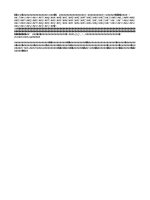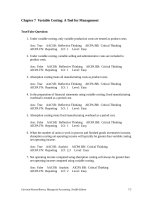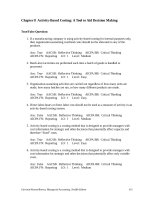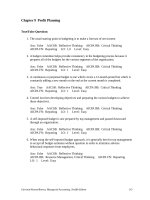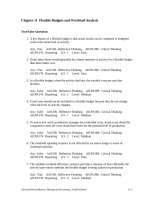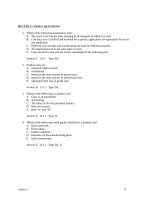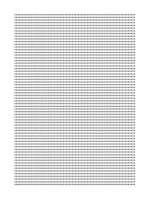Test bank managerial accounting by garrison 13e chapter 09
Bạn đang xem bản rút gọn của tài liệu. Xem và tải ngay bản đầy đủ của tài liệu tại đây (242.67 KB, 79 trang )
Chapter 9 Profit Planning
True/False Questions
1. The usual starting point in budgeting is to make a forecast of net income.
Ans: False AACSB: Reflective Thinking AICPA BB: Critical Thinking
AICPA FN: Reporting LO: 1,9 Level: Easy
2. A budget committee helps provide consistency in the budgeting process because it
prepares all of the budgets for the various segments of the organization.
Ans: False AACSB: Reflective Thinking AICPA BB: Critical Thinking
AICPA FN: Reporting LO: 1 Level: Easy
3. A continuous or perpetual budget is one which covers a 12-month period but which is
constantly adding a new month on the end as the current month is completed.
Ans: True AACSB: Reflective Thinking AICPA BB: Critical Thinking
AICPA FN: Reporting LO: 1 Level: Easy
4. Control involves developing objectives and preparing the various budgets to achieve
those objectives.
Ans: False AACSB: Reflective Thinking AICPA BB: Critical Thinking
AICPA FN: Reporting LO: 1 Level: Easy
5. A self-imposed budget is one prepared by top management and passed downward
through an organization.
Ans: False AACSB: Reflective Thinking AICPA BB: Critical Thinking
AICPA FN: Reporting LO: 1 Level: Easy
6. When using the self-imposed budget approach, it is generally best for top management
to accept all budget estimates without question in order to minimize adverse
behavioral responses from employees.
Ans: False AACSB: Reflective Thinking
AICPA BB: Resource Management, Critical Thinking
LO: 1 Level: Easy
Garrison/Noreen/Brewer, Managerial Accounting, Twelfth Edition
AICPA FN: Reporting
9-5
Chapter 9 Profit Planning
7. Cash collections in a schedule of cash collections typically consist of collections on
sales made to customers in prior periods plus collections on sales made in the current
budget period.
Ans: True AACSB: Reflective Thinking AICPA BB: Critical Thinking
AICPA FN: Reporting LO: 2 Level: Easy
8. In a production budget, if the number of units in finished goods inventory at the end of
the period is less than the number of units in finished goods inventory at the beginning
of the period, then the expected number of units sold is greater than the number of
units to be produced during the period.
Ans: True AACSB: Reflective Thinking AICPA BB: Critical Thinking
AICPA FN: Reporting LO: 3 Level: Medium
9. In a merchandising company, the required merchandise purchases for a period are
determined by subtracting the units in beginning inventory from the sum of the units
to be sold during the period and the desired ending inventory.
Ans: True AACSB: Reflective Thinking AICPA BB: Critical Thinking
AICPA FN: Reporting LO: 3 Level: Easy
10. The direct materials to be purchased for a period can be obtained by subtracting the
desired ending inventory of direct materials from the total direct materials needed for
the period.
Ans: False AACSB: Reflective Thinking AICPA BB: Critical Thinking
AICPA FN: Reporting LO: 4 Level: Medium
11. The direct labor budget begins with sales in units from the sales budget.
Ans: False AACSB: Reflective Thinking AICPA BB: Critical Thinking
AICPA FN: Reporting LO: 5 Level: Easy
12. The selling and administrative expense budget lists all costs of production other than
direct materials and direct labor.
Ans: False AACSB: Reflective Thinking AICPA BB: Critical Thinking
AICPA FN: Reporting LO: 6,7 Level: Easy
9-6
Garrison/Noreen/Brewer, Managerial Accounting, Twelfth Edition
Chapter 9 Profit Planning
13. In the manufacturing overhead budget, the non-cash charges (such as depreciation) are
deducted from the total budgeted manufacturing overhead to determine the expected
cash disbursements for manufacturing overhead.
Ans: True AACSB: Reflective Thinking AICPA BB: Critical Thinking
AICPA FN: Reporting LO: 6 Level: Easy
14. The selling and administrative expense budget lists the budgeted expenses for areas
other than manufacturing.
Ans: True AACSB: Reflective Thinking AICPA BB: Critical Thinking
AICPA FN: Reporting LO: 7 Level: Easy
15. The disbursements section of a cash budget consists of all cash payments for the
period except cash payments for dividends.
Ans: False AACSB: Reflective Thinking AICPA BB: Critical Thinking
AICPA FN: Reporting LO: 8 Level: Medium
16. Which of the following budgets are prepared before the sales budget?
A)
B)
C)
D)
Budgeted Income Statement Direct Labor Budget
Yes
Yes
Yes
No
No
Yes
No
No
Ans: D AACSB: Reflective Thinking AICPA BB: Critical Thinking
AICPA FN: Reporting LO: 1 Level: Easy
17. The usual starting point for a master budget is:
A) the direct materials purchase budget.
B) the budgeted income statement.
C) the sales forecast or sales budget.
D) the production budget.
Ans: C AACSB: Reflective Thinking AICPA BB: Critical Thinking
AICPA FN: Reporting LO: 1 Level: Easy
Garrison/Noreen/Brewer, Managerial Accounting, Twelfth Edition
9-7
Chapter 9 Profit Planning
18. Which of the following budgets are prepared before the cash budget?
A)
B)
C)
D)
Selling and Administrative Expense Budget Production Budget
Yes
Yes
Yes
No
No
Yes
No
No
Ans: A AACSB: Reflective Thinking AICPA BB: Critical Thinking
AICPA FN: Reporting LO: 1 Level: Medium
19. Which of the following benefits could an organization reasonably expect from an
effective budget program?
A) Better control of the organization's costs.
B) Better coordination of an organization's activities.
C) Better communication of the organization's objectives.
D) All of the above.
Ans: D AACSB: Reflective Thinking
AICPA BB: Resource Management, Critical Thinking
LO: 1 Level: Easy
AICPA FN: Reporting
20. An organization's budget program should not be used:
A) to motivate employees.
B) to assign blame to managers that do not meet budgetary goals.
C) to help evaluate managers.
D) to allocate resources to the various parts of an organization.
Ans: B AACSB: Reflective Thinking
AICPA BB: Resource Management, Critical Thinking
LO: 1 Level: Easy
AICPA FN: Reporting
21. A basic idea underlying __________________ is that a manager should be held
responsible only for those items that the manager can actually control to a significant
extent.
A) participative budgeting
B) planning and control
C) responsibility accounting
D) the master budget
Ans: C AACSB: Reflective Thinking
AICPA BB: Resource Management, Critical Thinking
LO: 1 Level: Easy
9-8
AICPA FN: Reporting
Garrison/Noreen/Brewer, Managerial Accounting, Twelfth Edition
Chapter 9 Profit Planning
22. When preparing a merchandise purchases budget, the required purchases in units
equals:
A) budgeted unit sales + beginning merchandise inventory + desired merchandise
ending inventory.
B) budgeted unit sales - beginning merchandise inventory + desired merchandise
ending inventory.
C) budgeted unit sales - beginning merchandise inventory - desired merchandise
ending inventory.
D) budgeted unit sales + beginning merchandise inventory - desired merchandise
ending inventory.
Ans: B AACSB: Reflective Thinking AICPA BB: Critical Thinking
AICPA FN: Reporting LO: 3 Level: Easy
23. When preparing a direct materials budget, the required purchases of raw materials in
units equals:
A) raw materials needed to meet the production schedule + desired ending
inventory of raw materials - beginning inventory of raw materials.
B) raw materials needed to meet the production schedule - desired ending inventory
of raw materials - beginning inventory of raw materials.
C) raw materials needed to meet the production schedule - desired ending inventory
of raw materials + beginning inventory of raw materials.
D) raw materials needed to meet the production schedule + desired ending
inventory of raw materials + beginning inventory of raw materials.
Ans: A AACSB: Reflective Thinking AICPA BB: Critical Thinking
AICPA FN: Reporting LO: 4 Level: Easy
24. Which of the following statements is NOT correct concerning the Manufacturing
Overhead Budget?
A) The Manufacturing Overhead Budget provides a schedule of all costs of
production other than direct materials and labor costs.
B) The Manufacturing Overhead Budget shows only the variable portion of
manufacturing overhead.
C) The Manufacturing Overhead Budget shows the expected cash disbursements
for manufacturing overhead.
D) The Manufacturing Overhead Budget is prepared after the Sales Budget.
Ans: B AACSB: Reflective Thinking AICPA BB: Critical Thinking
AICPA FN: Reporting LO: 6 Level: Easy
Garrison/Noreen/Brewer, Managerial Accounting, Twelfth Edition
9-9
Chapter 9 Profit Planning
25. Which of the following statements is NOT correct concerning the Cash Budget?
A) It is not necessary to prepare any other budgets before preparing the Cash
Budget.
B) The Cash Budget should be prepared before the Budgeted Income Statement.
C) The Cash Budget should be prepared before the Budgeted Balance Sheet.
D) The Cash Budget builds on earlier budgets and schedules as well as additional
data.
Ans: A AACSB: Reflective Thinking AICPA BB: Critical Thinking
AICPA FN: Reporting LO: 8 Level: Easy
26. Pitkins Company collects 20% of a month's sales in the month of sale, 70% in the
month following sale, and 6% in the second month following sale. The remainder is
uncollectible. Budgeted sales for the next four months are:
January February
March
April
Budgeted sales....... $200,000 $300,000 $350,000 $250,000
Cash collections in April are budgeted to be:
A) $321,000
B) $313,000
C) $320,000
D) $292,000
Ans: B AACSB: Analytic AICPA BB: Critical Thinking
AICPA FN: Reporting LO: 2 Level: Easy
Solution:
April sales ($250,000 × 20%)..............
March sales ($350,000 × 70%)...........
February sales ($300,000 × 6%).........
Total.....................................................
9-10
$ 50,000
245,000
18,000
$313,000
Garrison/Noreen/Brewer, Managerial Accounting, Twelfth Edition
Chapter 9 Profit Planning
27. Sioux Company is estimating the following sales for the first six months of next year:
January.......
February.....
March.........
April...........
May............
$250,000
$220,000
$240,000
$300,000
$360,000
Sales at Sioux are normally collected as 60% in the month of sale, 35% in the month
following the sale, and the remaining 5% being uncollectible. Based on this
information, how much cash should Sioux expect to collect during the month of April?
A) $250,800
B) $264,000
C) $290,700
D) $306,000
Ans: B AACSB: Analytic AICPA BB: Critical Thinking
AICPA FN: Reporting LO: 2 Level: Medium
Solution:
April sales ($300,000 × 60%).............
March sales ($240,000 × 35%)...........
Total.....................................................
$180,000
84,000
$264,000
Garrison/Noreen/Brewer, Managerial Accounting, Twelfth Edition
9-11
Chapter 9 Profit Planning
28. All of Gaylord Company's sales are on account. Thirty-five percent of the credit sales
are collected in the month of sale, 45% in the month following sale, and the rest are
collected in the second month following sale. Bad debts are negligible and should be
ignored. The following are budgeted sales data for the company:
Total sales...............
January February March
April
$50,000 $60,000 $40,000 $30,000
What is the amount of cash that should be collected in March?
A) $39,000
B) $37,000
C) $27,500
D) $51,000
Ans: D AACSB: Analytic AICPA BB: Critical Thinking
AICPA FN: Reporting LO: 2 Level: Easy
Solution:
March sales ($40,000 × 35%)..............
February sales ($60,000 × 45%).........
January sales ($50,000 × 20%*).........
Total.....................................................
*100% − 35% − 45% = 20%
$14,000
27,000
10,000
$51,000
29. On January 1, Barnes Company has 8,000 units of Product A on hand. During the year,
the company plans to sell 30,000 units of Product A, and plans to have 6,500 units on
hand at year end. How many units of Product A must be produced during the year?
A) 28,500
B) 31,500
C) 30,000
D) 36,500
Ans: A AACSB: Analytic AICPA BB: Critical Thinking
AICPA FN: Reporting LO: 3 Level: Easy
Solution:
Units produced = Ending inventory + Units sold − Beginning inventory
= 6,500 + 30,000 − 8,000
= 28,500
9-12
Garrison/Noreen/Brewer, Managerial Accounting, Twelfth Edition
Chapter 9 Profit Planning
30. Betz Company's sales budget shows the following projections for next year:
First Quarter.......................
Second Quarter...................
Third Quarter.....................
Fourth Quarter....................
Sales in units
60,000
80,000
45,000
55,000
Inventory at the beginning of the year was 18,000 units. The finished goods inventory
at the end of each quarter is to equal 30% of the next quarter's budgeted unit sales.
How many units should be produced during the first quarter?
A) 24,000
B) 48,000
C) 66,000
D) 72,000
Ans: C AACSB: Analytic AICPA BB: Critical Thinking
AICPA FN: Reporting LO: 3 Level: Medium Source: CPA, adapted
Solution:
Units produced = Ending inventory + Units sold + Beginning inventory
= (30% × 80,000) + 60,000 − 18,000
= 24,000 + 60,000 − 18,000 = 66,000
Garrison/Noreen/Brewer, Managerial Accounting, Twelfth Edition
9-13
Chapter 9 Profit Planning
31. The following information relates to Minorca Manufacturing Corporation for next
quarter:
January February
March
Expected sales (in units)............................ 440,000 390,000 400,000
Desired ending finished goods inventory
(in units)................................................. 28,000
30,000 35,000
How many units should Minorca plan on producing for the month of February?
A) 360,000 units
B) 388,000 units
C) 392,000 units
D) 420,000 units
Ans: C AACSB: Analytic AICPA BB: Critical Thinking
AICPA FN: Reporting LO: 3 Level: Medium
Solution:
Ending inventory + Units sold − Beginning inventory
= 30,000 + 390,000 - 28,000 = 392,000
9-14
Garrison/Noreen/Brewer, Managerial Accounting, Twelfth Edition
Chapter 9 Profit Planning
32. MJ Department Store expects to generate the following sales figures for the next three
months:
July
August September
Expected sales........ $480,000 $560,000 $600,000
MJ's gross profit rate is 45% of sales dollars. At the end of each month, MJ wants a
merchandise inventory balance equal to 30% of the following month's expected sales,
stated at cost. What dollar amount of merchandise inventory should MJ plan to
purchase in August?
A) $257,400
B) $314,600
C) $320,000
D) $327,800
Ans: B AACSB: Analytic AICPA BB: Critical Thinking
AICPA FN: Reporting LO: 3 Level: Hard
Solution:
Inventory cost is 55% of sales dollars (1 – 45% gross profit rate)
Inventory purchased = Ending inventory + Sales − Beginning inventory
= [($600,000 × 30%) × 55%] + ($560,000 × 55%) − [($560,000 × 30%) × 55%]
= ($180,000 × 55%) + $308,000 − ($168,000 × 55%)
= $99,000 + $308,000 − $92,400 = $314,600
33. On October 1, The Gala Manufacturing Company has 300 units of Product XYZ on
hand. The company plans to sell 1,200 units of Product XYZ during October, and
plans to have 500 units on hand October 31. How many units of Product XYZ must be
produced during October?
A) 1,400
B) 1,500
C) 1,000
D) 2,000
Ans: A AACSB: Analytic AICPA BB: Critical Thinking
AICPA FN: Reporting LO: 3 Level: Easy
Solution:
Units produced = Ending inventory + Units sold − Beginning inventory
= 500 + 1,200 − 300 = 1,400
Garrison/Noreen/Brewer, Managerial Accounting, Twelfth Edition
9-15
Chapter 9 Profit Planning
34. The following are budgeted data:
Sales in units......................
Production in units.............
Month 1 Month 2 Month 3
15,000
20,000
18,000
16,000
22,000
15,000
One pound of material is required for each finished unit. The inventory of materials at
the end of each month should equal 20% of the following month's production needs.
At the beginning of Month 1, 3,200 lbs. of materials were on hand. Purchases of raw
materials for Month 2 would be budgeted to be:
A) 17,600 pounds
B) 23,400 pounds
C) 20,600 pounds
D) 25,000 pounds
Ans: C AACSB: Analytic AICPA BB: Critical Thinking
AICPA FN: Reporting LO: 4 Level: Medium
Solution:
Materials purchased = Ending inventory + Materials used − Beginning inventory
= (20% × 15,000) + 22,000 − (20% × 22,000)
= 3,000 + 22,000 − 4,400 = 20,600
35. Alexis Fabrication, Inc. manufactures and sells box trailers for semi trucks. Each
trailer requires two (2) axles. For next quarter, Alexis has scheduled 720 trailers for
production and 750 for sale. Alexis is also moving to just-in-time purchasing next
quarter and plans on reducing its inventory of trailer axles by 100. How many axles
should Alexis budget for purchase for next quarter?
A) 1,240 axles
B) 1,300 axles
C) 1,340 axles
D) 1,400 axles
Ans: C AACSB: Analytic AICPA BB: Critical Thinking
AICPA FN: Reporting LO: 4 Level: Medium
Solution:
Materials to be purchased = Ending inventory + Materials to be used − Beginning
inventory
= Materials to be used + (Ending inventory − Beginning inventory)
= (720 × 2) − 100 = 1,440 − 100 = 1,340
9-16
Garrison/Noreen/Brewer, Managerial Accounting, Twelfth Edition
Chapter 9 Profit Planning
36. Garry Manufacturing Corporation's most recent production budget indicates the
following required production:
October
Required production (units)........... 210,000
November
175,000
December
110,000
Each unit of finished product requires 5 pounds of raw materials. The company
maintains raw materials inventory equal to 25% of the next month's expected
production needs. How many pounds of raw material should Garry plan on purchasing
for the month of November?
A) 1,006,250
B) 793,750
C) 1,012,500
D) 893,500
Ans: B AACSB: Analytic AICPA BB: Critical Thinking
AICPA FN: Reporting LO: 4 Level: Easy
Solution:
Materials to be purchased = Ending inventory + Materials to be used − Beginning
inventory
= (25% × 110,000 × 5) + (175,000 × 5) − (25% × 175,000 × 5)
= 137,500 + 875,000 − 218,750 = 793,750
37. Depasquale Corporation is working on its direct labor budget for the next two months.
Each unit of output requires 0.41 direct labor-hours. The direct labor rate is $8.10 per
direct labor-hour. The production budget calls for producing 5,000 units in May and
5,400 units in June. If the direct labor work force is fully adjusted to the total direct
labor-hours needed each month, what would be the total combined direct labor cost for
the two months?
A) $16,605.00
B) $17,933.40
C) $17,269.20
D) $34,538.40
Ans: D AACSB: Analytic AICPA BB: Critical Thinking
AICPA FN: Reporting LO: 5 Level: Easy
Solution:
Total direct labor-hours = 0.41 × (5,000 + 5,400) = 4,264
Direct labor cost = 4,264 × $8.10 = $34,538.40
Garrison/Noreen/Brewer, Managerial Accounting, Twelfth Edition
9-17
Chapter 9 Profit Planning
38. Pooler Corporation is working on its direct labor budget for the next two months. Each
unit of output requires 0.15 direct labor-hours. The direct labor rate is $7.00 per direct
labor-hour. The production budget calls for producing 6,500 units in April and 6,200
units in May. The company guarantees its direct labor workers a 40-hour paid work
week. With the number of workers currently employed, that means that the company is
committed to paying its direct labor work force for at least 1,000 hours in total each
month even if there is not enough work to keep them busy. What would be the total
combined direct labor cost for the two months?
A) $13,825.00
B) $13,335.00
C) $14,000.00
D) $13,510.00
Ans: C AACSB: Analytic AICPA BB: Critical Thinking
AICPA FN: Reporting LO: 5 Level: Easy
Solution:
Direct labor-hours needed for production in April = 0.15 × 6,500 = 975
Direct labor-hours needed for production in May = 0.15 × 6,200 = 930
Even though both months’ production needs would require less than 1,000 hours, the
company has committed to paying a minimum of 1,000 hours per month.
Total direct labor-hours = 1,000 + 1,000 = 2,000
Direct labor cost = 2,000 × $7 = $14,000
9-18
Garrison/Noreen/Brewer, Managerial Accounting, Twelfth Edition
Chapter 9 Profit Planning
39. Traverse Company manufactures and sells women's skirts. Each skirt (unit) requires
2.5 yards of cloth. Selected data from Traverse's master budget for next quarter are
shown below:
July August September
Budgeted sales (in units)................ 6,000
8,000
9,000
Budgeted production (in units)...... 8,000 10,500
12,000
Each unit requires 1.5 hours of direct labor, and the average hourly cost of Traverse's
direct labor is $10. What is the cost of Traverse Company's direct labor in September?
A) $135,000
B) $180,000
C) $157,500
D) $120,000
Ans: B AACSB: Analytic AICPA BB: Critical Thinking
AICPA FN: Reporting LO: 5 Level: Easy
Solution:
12,000 × 1.5 × $10 = $180,000
40. Haylock Inc. bases its manufacturing overhead budget on budgeted direct labor-hours.
The direct labor budget indicates that 5,600 direct labor-hours will be required in
August. The variable overhead rate is $5.40 per direct labor-hour. The company's
budgeted fixed manufacturing overhead is $69,440 per month, which includes
depreciation of $15,680. All other fixed manufacturing overhead costs represent
current cash flows. The August cash disbursements for manufacturing overhead on the
manufacturing overhead budget should be:
A) $99,680
B) $84,000
C) $53,760
D) $30,240
Ans: B AACSB: Analytic AICPA BB: Critical Thinking
AICPA FN: Reporting LO: 6 Level: Easy
Solution:
Variable manufacturing overhead + Fixed manufacturing overhead
= (5,600 × $5.40) + ($69,440 − $15,680)
= $30,240 + $53,760 = $84,000
Garrison/Noreen/Brewer, Managerial Accounting, Twelfth Edition
9-19
Chapter 9 Profit Planning
41. Arciba Inc. bases its manufacturing overhead budget on budgeted direct labor-hours.
The direct labor budget indicates that 7,400 direct labor-hours will be required in
January. The variable overhead rate is $9.50 per direct labor-hour. The company's
budgeted fixed manufacturing overhead is $130,980 per month, which includes
depreciation of $10,360. All other fixed manufacturing overhead costs represent
current cash flows. The company recomputes its predetermined overhead rate every
month. The predetermined overhead rate for January should be:
A) $27.20
B) $25.80
C) $17.70
D) $9.50
Ans: A AACSB: Analytic AICPA BB: Critical Thinking
AICPA FN: Reporting LO: 6 Level: Easy
Solution:
$9.50 + ($130,980 ÷ 7,400) = $9.50 + $17.70 = $27.20
42. The manufacturing overhead budget at Foshay Corporation is based on budgeted
direct labor-hours. The direct labor budget indicates that 5,800 direct labor-hours will
be required in May. The variable overhead rate is $9.10 per direct labor-hour. The
company's budgeted fixed manufacturing overhead is $104,400 per month, which
includes depreciation of $8,120. All other fixed manufacturing overhead costs
represent current cash flows. The company recomputes its predetermined overhead
rate every month. The predetermined overhead rate for May should be:
A) $9.10
B) $27.10
C) $18.00
D) $25.70
Ans: B AACSB: Analytic AICPA BB: Critical Thinking
AICPA FN: Reporting LO: 6 Level: Easy
Solution:
$9.10 + ($104,400 ÷ 5,800) = $9.10 + $18 = $27.10
9-20
Garrison/Noreen/Brewer, Managerial Accounting, Twelfth Edition
Chapter 9 Profit Planning
43. The manufacturing overhead budget at Franklyn Corporation is based on budgeted
direct labor-hours. The direct labor budget indicates that 4,400 direct labor-hours will
be required in January. The variable overhead rate is $1.30 per direct labor-hour. The
company's budgeted fixed manufacturing overhead is $60,280 per month, which
includes depreciation of $17,160. All other fixed manufacturing overhead costs
represent current cash flows. The January cash disbursements for manufacturing
overhead on the manufacturing overhead budget should be:
A) $5,720
B) $43,120
C) $48,840
D) $66,000
Ans: C AACSB: Analytic AICPA BB: Critical Thinking
AICPA FN: Reporting LO: 6 Level: Easy
Solution:
(4,400 × $1.30) + ($60,280 − $17,160) = $5,720 + $43,120 = $48,840
44. Schuepfer Inc. bases its selling and administrative expense budget on budgeted unit
sales. The sales budget shows 1,300 units are planned to be sold in March. The
variable selling and administrative expense is $4.20 per unit. The budgeted fixed
selling and administrative expense is $19,240 per month, which includes depreciation
of $3,380 per month. The remainder of the fixed selling and administrative expense
represents current cash flows. The cash disbursements for selling and administrative
expenses on the March selling and administrative expense budget should be:
A) $15,860
B) $5,460
C) $24,700
D) $21,320
Ans: D AACSB: Analytic AICPA BB: Critical Thinking
AICPA FN: Reporting LO: 7 Level: Easy
Solution:
(1,300 × $4.20) + ($19,240 − $3,380) = $5,460 + $15,860 = $21,320
Garrison/Noreen/Brewer, Managerial Accounting, Twelfth Edition
9-21
Chapter 9 Profit Planning
45. The selling and administrative expense budget of Choo Corporation is based on
budgeted unit sales, which are 4,600 units for August. The variable selling and
administrative expense is $7.30 per unit. The budgeted fixed selling and administrative
expense is $51,980 per month, which includes depreciation of $6,440 per month. The
remainder of the fixed selling and administrative expense represents current cash
flows. The cash disbursements for selling and administrative expenses on the August
selling and administrative expense budget should be:
A) $85,560
B) $45,540
C) $79,120
D) $33,580
Ans: C AACSB: Analytic AICPA BB: Critical Thinking
AICPA FN: Reporting LO: 7 Level: Easy
Solution:
(4,600 × $7.30) + ($51,980 − $6,440) = $33,580 + $45,540 = $79,120
46. Sedita Inc. is working on its cash budget for July. The budgeted beginning cash
balance is $46,000. Budgeted cash receipts total $175,000 and budgeted cash
disbursements total $174,000. The desired ending cash balance is $50,000. The excess
(deficiency) of cash available over disbursements for July will be:
A) $47,000
B) $221,000
C) $45,000
D) $1,000
Ans: A AACSB: Analytic AICPA BB: Critical Thinking
AICPA FN: Reporting LO: 8 Level: Easy
Solution:
Excess cash available = Beginning cash balance + Cash receipts − Cash disbursements
= $46,000 + $175,000 − $174,000 = $47,000
9-22
Garrison/Noreen/Brewer, Managerial Accounting, Twelfth Edition
Chapter 9 Profit Planning
47. Bustillo Inc. is working on its cash budget for March. The budgeted beginning cash
balance is $35,000. Budgeted cash receipts total $142,000 and budgeted cash
disbursements total $151,000. The desired ending cash balance is $30,000. To attain
its desired ending cash balance for March, the company needs to borrow:
A) $0
B) $4,000
C) $56,000
D) $30,000
Ans: B AACSB: Analytic AICPA BB: Critical Thinking
AICPA FN: Reporting LO: 8 Level: Easy
Solution:
Actual ending cash balance = Beginning cash balance + Cash receipts − Cash
disbursements = $35,000 + $142,000 − $151,000 = $26,000
Amount borrowed = Desired ending cash balance − Actual ending cash balance
= $30,000 − $26,000 = $4,000
48. Francis Manufacturing Company is currently preparing its cash budget for next month
and has gathered the following information:
Expected cash receipts...............................
Expected disbursements:
Direct materials.......................................
Direct labor.............................................
Manufacturing overhead.........................
Selling and administrative expenses.......
$39,400
$12,000
$9,000
$11,500
$22,000
The beginning cash balance will be $6,000 and the company requires a minimum cash
balance at the end of the month of $5,000. How much will Francis Manufacturing
need to borrow to meet its cash needs for the month?
A) $9,100
B) $14,100
C) $20,100
D) None of the above.
Ans: B AACSB: Analytic AICPA BB: Critical Thinking
AICPA FN: Reporting LO: 8 Level: Easy
Garrison/Noreen/Brewer, Managerial Accounting, Twelfth Edition
9-23
Chapter 9 Profit Planning
Solution:
Actual ending cash balance = Beginning cash balance + Cash receipts − Cash
disbursements = $6,000 + $39,400 − ($12,000 + $9,000 + $11,500 + $22,000)
= $45,400 − $54,500 = ($9,100)
Amount borrowed = Desired ending cash balance − Actual ending cash balance
= $5,000 − ($9,100) = $14,100
Use the following to answer questions 49-50:
KAB Inc., a small retail store, had the following results for May. The budgets for June and
July are also given.
Sales............................................................
Less cost of goods sold...............................
Gross margin...............................................
Less selling and administrative expenses....
Net operating income..................................
May
June
July
(actual) (budget) (budget)
$42,000 $40,000 $45,000
21,000
20,000
22,500
21,000
20,000
22,500
20,000
20,000
20,000
$ 1,000 $
0 $ 2,500
Sales are collected 80% in the month of the sale and the balance in the month following the
sale. (There are no bad debts.) The goods that are sold are purchased in the month prior to
sale. Suppliers of the goods are paid in the month following the sale. The "selling and
administrative expenses" are paid in the month of the sale.
49. The amount of cash collected during the month of June should be:
A) $32,000
B) $40,000
C) $40,400
D) $41,000
Ans: C AACSB: Analytic AICPA BB: Critical Thinking
AICPA FN: Reporting LO: 2 Level: Easy Source: CMA, adapted
Solution:
June sales ($40,000 × 80%).................
May sales ($42,000 × 20%).................
Total.....................................................
9-24
$32,000
8,400
$40,400
Garrison/Noreen/Brewer, Managerial Accounting, Twelfth Edition
Chapter 9 Profit Planning
50. The cash disbursements during the month of June for goods purchased for resale and
for selling and administrative expenses should be:
A) $40,000
B) $41,000
C) $42,500
D) $43,500
Ans: B AACSB: Analytic AICPA BB: Critical Thinking
AICPA FN: Reporting LO: 3,4 Level: Easy Source: CMA, adapted
Solution:
May purchases of goods..................................
June selling and administrative expenses........
Total.................................................................
Garrison/Noreen/Brewer, Managerial Accounting, Twelfth Edition
$21,000
20,000
$41,000
9-25
Chapter 9 Profit Planning
Use the following to answer questions 51-59:
Dilly Farm Supply is located in a small town in the rural west. Data regarding the store's
operations follow:
Sales are budgeted at $290,000 for November, $310,000 for December, and $210,000
for January.
Collections are expected to be 65% in the month of sale, 33% in the month following
the sale, and 2% uncollectible.
The cost of goods sold is 80% of sales.
The company purchases 70% of its merchandise in the month prior to the month of
sale and 30% in the month of sale. Payment for merchandise is made in the month
following the purchase.
Other monthly expenses to be paid in cash are $21,100.
Monthly depreciation is $21,000.
Ignore taxes.
Statement of Financial Position
October 31
Assets:
Cash............................................................................................... $ 25,000
Accounts receivable
(net of allowance for uncollectible accounts)............................
77,000
Inventory........................................................................................
162,400
Property, plant and equipment
(net of $624,000 accumulated depreciation).............................. 1,026,000
Total assets..................................................................................... $1,290,400
Liabilities and Stockholders’ Equity:
Accounts payable........................................................................... $ 239,000
Common stock...............................................................................
740,000
Retained earnings...........................................................................
311,400
Total liabilities and stockholders’ equity....................................... $1,290,400
9-26
Garrison/Noreen/Brewer, Managerial Accounting, Twelfth Edition
Chapter 9 Profit Planning
51. Expected cash collections in December are:
A) $310,000
B) $95,700
C) $297,200
D) $201,500
Ans: C AACSB: Analytic AICPA BB: Critical Thinking
AICPA FN: Reporting LO: 2 Level: Hard
Solution:
December sales ($310,000 × 65%).....
November sales ($290,000 × 33%).....
Total.....................................................
$201,500
95,700
$297,200
52. The cost of December merchandise purchases would be:
A) $248,000
B) $232,000
C) $117,600
D) $192,000
Ans: D AACSB: Analytic AICPA BB: Critical Thinking
AICPA FN: Reporting LO: 3 Level: Hard
Solution:
Cost of
Sales
Goods Sold
November............................................
$290,000
$232,000
December............................................
$310,000
$248,000
January................................................
$210,000
$168,000
Merchandise purchases = Ending inventory + Cost of goods sold − Beginning
inventory = ($168,000 × 70%) + $248,000 − ($248,000 × 70%)
= $117,600 + $248,000 − $173,600 = $192,000
Garrison/Noreen/Brewer, Managerial Accounting, Twelfth Edition
9-27
Chapter 9 Profit Planning
53. December cash disbursements for merchandise purchases would be:
A) $192,000
B) $243,200
C) $117,600
D) $248,000
Ans: B AACSB: Analytic AICPA BB: Critical Thinking
AICPA FN: Reporting LO: 3 Level: Hard
Solution:
Cost of
Sales Goods Sold
November............................................
$290,000
$232,000
December............................................
$310,000
$248,000
January................................................
$210,000
$168,000
December cash disbursements = 70% of December Cost of Goods Sold + 30% of
November Cost of Good Sold = (70% × $248,000) + (30% × $232,000)
= $173,600 + $69,600 = $243,200
54. The excess (deficiency) of cash available over disbursements for December would be:
A) $46,600
B) $19,200
C) $13,700
D) $32,900
Ans: D AACSB: Analytic AICPA BB: Critical Thinking
AICPA FN: Reporting LO: 8 Level: Hard
Solution:
Cash collections − Cash disbursements − Other monthly expenses
= $297,200 − $243,200 − $21,100 = $32,900
9-28
Garrison/Noreen/Brewer, Managerial Accounting, Twelfth Edition
Chapter 9 Profit Planning
55. The net income for December would be:
A) $13,700
B) $32,900
C) $40,900
D) $19,900
Ans: A AACSB: Analytic AICPA BB: Critical Thinking
AICPA FN: Reporting LO: 9 Level: Hard
Solution:
Sales....................................................
Less uncollectible ($310,000 × 2%)....
Net sales..............................................
Cost of goods sold ($310,000 × 80%).
Other expenses....................................
Depreciation expenses.........................
Net income..........................................
$310,000
6,200
303,800
248,000
21,100
21,000
$ 13,700
Garrison/Noreen/Brewer, Managerial Accounting, Twelfth Edition
9-29
